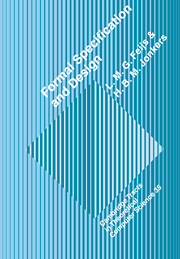Book contents
- Frontmatter
- Contents
- List of figures
- List of tables
- Preface
- I Algebraic specification
- 1 Introducing the basic concepts
- 2 Setting up algebraic specifications
- 3 Structuring algebraic specifications
- 4 Implementing algebraic specifications
- II State-based specification
- III Advanced techniques
- Bibliography
- A Syntax
- B Standard library
- Index
2 - Setting up algebraic specifications
Published online by Cambridge University Press: 02 November 2009
- Frontmatter
- Contents
- List of figures
- List of tables
- Preface
- I Algebraic specification
- 1 Introducing the basic concepts
- 2 Setting up algebraic specifications
- 3 Structuring algebraic specifications
- 4 Implementing algebraic specifications
- II State-based specification
- III Advanced techniques
- Bibliography
- A Syntax
- B Standard library
- Index
Summary
Introduction
This chapter is about setting up flat algebraic specifications. This involves the introduction of more COLD-K constructs and the formulation of various methodological guidelines. At the end of the previous chapter we had to conclude that we almost succeeded in specifying the natural numbers, the only problem being that the expressive power to express the minimality of Nat was lacking. This expressive power will be available after we have introduced the inductive predicate definitions below. We shall complete the example of the natural numbers and we shall investigate various technical aspects of inductive definitions – which unfortunately are quite non-trivial. In addition to inductive predicate definitions, we shall also have inductive function definitions. We address issues like ‘proof obligations’ for inductive definitions, consistency and completeness. Finally we give a number of complete examples of flat algebraic specifications: queues, stacks, bags and symbolic expressions.
Inductive predicate definitions
An inductive predicate definition defines a predicate as the least predicate satisfying some assertion (provided that this predicate exists). Before turning our attention to the syntactic machinery available in COLD-K for expressing this, we ought to explain this notion of ‘least’. Therefore we shall formulate what we mean by one predicate being ‘less than or equal to’ another predicate.
Definition. A predicate r is less than or equal to a predicate q if for each argument x we have that r(x) implies q(x).
We illustrate this definition by means of two unary predicates p1 and p2. We assume the sort Nat with its operations zero and succ as specified before.
- Type
- Chapter
- Information
- Formal Specification and Design , pp. 33 - 58Publisher: Cambridge University PressPrint publication year: 1992



